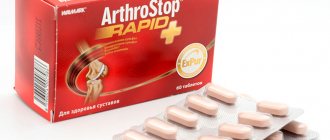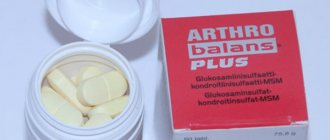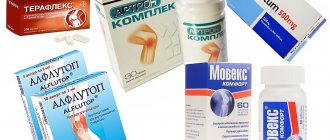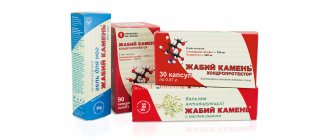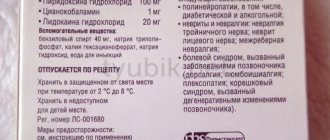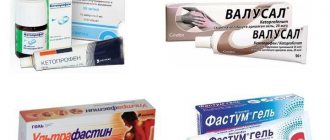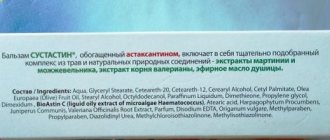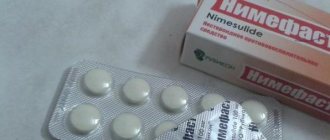Movalis is a non-steroidal anti-inflammatory drug that has a complex effect on all manifestations of inflammation. Gives anti-inflammatory, analgesic and antipyretic effect. The drug relieves unpleasant subjective sensations, and also breaks pathogenetic chains in the development of inflammatory reactions of various origins and localization. The main mechanism of action of meloxicam on inflammatory mediators is inhibition of prostaglandin synthesis.
Release form and composition
The drug Movalis is available in the form of tablets, injection solution and rectal suppositories. Each release form is more effective for certain pathologies.
Movalis tablets 15 mg, 10 or 20 pieces - contain the active ingredient meloxicam in an amount of 15 mg, as well as excipients: lactose monohydrate - 20 mg, sodium citrate dihydrate - 30 mg, MCC (microcrystalline cellulose) - 87.3 mg, povidone K25 - 9 mg, colloidal silicon dioxide - 3 mg, crospovidone - 14 mg, magnesium stearate - 1.7 mg.
Movalis tablets 7.5 mg, 10 pieces - contain the active ingredient meloxicam in an amount of 7.5 mg, as well as excipients: lactose monohydrate - 23.5 mg, sodium citrate dihydrate - 15 mg, MCC (microcrystalline cellulose) - 102 mg, povidone K25 - 10.5 mg, colloidal silicon dioxide - 3.5 mg, crospovidone - 16.3 mg, magnesium stearate - 1.7 mg.
Rectal suppositories Movalis 15 mg, 6 pieces - each suppository contains 15 mg of meloxicam and excipients: Suppocire BP solid fat, polyethoxylated ricin oil, hydrogenated.
Rectal suppositories Movalis 7.5 mg, 6 pieces - contain 7.5 mg of meloxicam and excipients: Suppocire BP solid fat, polyethoxylated ricin oil, hydrogenated.
Movalis injection solution 15 mg/1.5 ml, 3 or 5 ampoules - this release form includes meloxicam 15 mg, as well as excipients: meglumine, poloxamer 188, sodium chloride, sodium hydroxide E524, glycine E640, glycofurol, water for injection, sterile, up to 1.5 ml.
Oral suspension Movalis 7.5 mg/5 ml - 5 ml of the drug contains the active ingredient meloxicam 7.5 mg, as well as excipients: colloidal silicon dioxide - 50.00 mg, hyaetellose - 5.00 mg, sorbitol - 1750 .00 mg, glycerol - 750.00 mg, xylitol - 750.00 mg, sodium dihydrogen phosphate dihydrate - 100.00 mg, sodium saccharinate - 0.50 mg, sodium benzoate - 7.50 mg, citric acid monohydrate - 6.00 mg, raspberry flavor - 10.00 mg, purified water - 2463.50 mg.
Mataren
The domestic drug is characterized as an excellent remedy for local pain. Ingredients: meloxicam - 30 mg, capsicum tincture - 100 g. Available only in ointment and tablet formats. It is successfully used to treat pain in joint diseases and has an anti-edematous effect. Side effects: possible allergies, skin peeling. Contraindications: violation of the integrity and inflammation of the skin, sensitivity to the elements. Comparison of original and analogue:
| Characteristics | Movalis | Mataren |
| Bioavailability, % | 99 | 99 |
| Maximum concentration, hour | 5-6 | 1 |
| Withdrawal time, hour | 20 | 7-8 |
pharmachologic effect
Pharmacodynamics
Movalis contains meloxicam, the main effect of which is the ability to block the synthesis and release of prostaglandins at each stage of their biochemical transformation. The ability to block COX-2, which is one of the main mediators of acute phase inflammation, stands out separately.
The effect of the drug is specific, so COX-1 is not inhibited, which reduces the number of side effects. The highest intensity of exposure is observed at the site of inflammation, and not in peripheral tissues.
It is noted that due to the confirmed high specificity, Movalis does not cause the classic side effect of non-steroidal anti-inflammatory drugs in the form of an effect on platelet aggregation, which avoids an increased risk of bleeding.
Pharmacokinetics
The drug has high bioavailability - 90%, absorption occurs completely in the intestine. The maximum concentration in blood plasma is achieved 5-6 hours after oral administration and 2-3 hours after the injection. Moreover, the bioavailability of injection forms is 100%. Absorption of the drug does not depend on food intake.
Meloxicam quickly passes into a chemically bound form, having a high affinity for proteins, in particular albumins. The binding rate is 99%. Active forms of the drug penetrate into the synovial fluid of the joint capsules, where the concentration is reduced by half compared to blood plasma. With prolonged and systematic use, the concentration in the synovial fluid increases.
The biotransformation of meloxicam occurs mainly in the liver with the participation of cytochromes of the CYP 2C9 and CYP 3A4 families. The toxicity of the drug does not increase during its metabolism; the 4 main metabolites are pharmacologically inactive and are excreted in the urine. Elimination occurs in feces and urine, about 5% of the substance is excreted unchanged.
Amelotex
The drug Amelotex is a domestic substitute for Movalis in ampoules with the same active ingredient. Contraindications and side effects for use are similar. The medicine acts quickly and remains in the blood for a long time after administration. A comparison of the difference in activity of the drugs is given below:
| Characteristics | Movalis | Amelotex |
| Bioavailability, % | 99 | 99 |
| Maximum concentration, hour | 5-6 | 5-6 |
| Withdrawal time, hour | 20 | 15 |
- Child benefit
- Treatment of toenail fungus with Iodinol, reviews of the results
- Floristry for beginners - step by step assembly of bouquets. Fundamentals and styles of floristry for composing compositions
Indications for use of Movalis
The medicine is used to relieve symptoms of inflammation, including fever, pain, local swelling, and redness. The drug is especially effective in the symptomatic treatment of diseases of the musculoskeletal system, degenerative diseases of the skeleton and muscular system, with causalgic pain and other diseases. The main diseases that are indications for the use of Movalis, as well as dosages to achieve maximum therapeutic effect, are listed below. It is not recommended to exceed the dosage of 15 mg/day. Indications:
- Movalis for osteochondrosis is indicated for use in tablet form at 15 mg/day; with a decrease in symptoms, the dose can be reduced to 7.5 mg/day.
- Movalis for ankylosing spondylitis can be used at a dosage of 15 mg/day orally, but in patients with an increased risk from the cardiovascular system, the therapeutic dose should start at 7.5 mg/day and increase if necessary under the supervision of the attending physician.
- Movalis for neuralgia of any origin can be used symptomatically to relieve pain at a dose of 7.5 mg/day, one tablet once a day.
- Movalis for lower back pain is recommended only when local painkillers are not effective. In this case, a dose of 7.5 mg/day is recommended.
- For pinched nerves, Movalis is indicated for pain relief at a dose of 7.5 mg/day; you can use one tablet or one rectal suppository of 7.5 mg, respectively.
- Movalis for a spinal hernia with progressive pain syndrome, lumbago or lumbar ischialgia, an injection of Movalis 7.5 mg once or 15 mg tablet forms is indicated.
- Movalis for radiculitis is used in doses of 7.5 or 15 mg per day; if this dosage form is not effective, you can use injections of 15 mg once a day. The course of injection treatment should not last more than 3 days with a maximum daily dose of 15 mg.
- Movalis for arthritis, including rheumatoid origin, is used at 15 mg/day, one 15 mg tablet once in the morning or two 7.5 mg tablets in the morning and evening. In the presence of an acute attack of rheumatoid arthritis, injections may be used, but only in cases where tablet forms and suppositories cannot be used or are not effective. Movalis injections are limited to one injection of 15 mg/day.
The justification for using Movalis should be determined by a physician based on the specific pathological condition that can be treated. Dose adjustments are made based on the patient's feedback on how they feel, the reduction of symptoms, or the presence of adverse reactions.
What is Movalis
The basis of this non-steroidal anti-inflammatory drug (NSAID) Movalis is the active substance meloxicam, the mechanism of action of which is to selectively slow down the synthesis of prostaglandin enzymes that cause inflammation. This drug at the same time:
- fights inflammation;
- relieves high fever;
- eliminates acute pain.
An anesthetic medicine with an antipyretic effect in injection solutions is recommended for severe pain in diseased joints (arthritis, arthrosis), spinal diseases, rheumatoid diseases, osteoarthritis, spondylitis, neuralgia and pinched nerves at the beginning of treatment, when the pain syndrome is pronounced. The drug has a long-lasting effect and does not have many undesirable side effects that are characteristic of drugs of this non-steroidal anti-inflammatory group.
Contraindications
It is not recommended to take meloxicam in patients with developed sensitization to the components of the drug. Contraindicated in patients who have developed symptoms of asthma, swelling, nasal breathing problems or urticaria after taking non-steroidal anti-inflammatory drugs, including derivatives of acetylsalicylic and enolic acids. Taking Movalis is contraindicated:
- During the third trimester of pregnancy, the use of drugs based on meloxicam can lead to impaired blood circulation in the fetus, the development of cardiopulmonary failure, pathology of the urinary system, in particular progressive renal failure. During this same period, the medicine can have a detrimental effect on the course of labor.
- Pathology of the gastrointestinal tract, in the presence of gastric bleeding or perforation of an ulcer, especially if they are caused by the systematic use of a non-steroidal anti-inflammatory drug. A history of gastrointestinal bleeding requires recalculation of the dose and use of other classes of drugs.
- Severe liver failure is a direct contraindication, since the drug undergoes biotransformation with the participation of cytochromes and other liver enzymes. Taking Movalis for functional liver failure can lead to the development of complications.
- Severe renal failure without dialysis. It should be borne in mind that during peritoneal dialysis or hemodialysis the drug can be prescribed with caution, as its elimination will occur.
- Ages under 16 years are a direct contraindication to the use of Movalis due to the peculiarities of biotransformation and distribution of the drug, as well as the development of immediate allergic reactions in this age category. It is impossible to select a safe dose for use in such patients without the risk of adverse reactions.
- Disorders of the blood coagulation system, which are manifested by the presence of bleeding that is difficult to stop, a history of cerebrovascular bleeding and are confirmed by the results of laboratory tests.
- Severe heart failure.
- Simultaneous use of anticoagulants.
Movasin
This is the cheapest analogue of Movalis in injections among other similar drugs. The drug is produced in Russia and Belarus. It is prescribed strictly for 2-3 days, which indicates a depressing side effect on the gastrointestinal tract and circulatory system. Comparative data is shown below:
| Characteristics | Movalis | Movasin |
| Bioavailability, % | 99 | 90 |
| Maximum concentration, hour | 5-6 | 2-5 |
| Withdrawal time, hour | 20 | 19-20 |
Side effects
Side effects are classified depending on the affected organs and systems, as well as by frequency of occurrence in a similar way: very common (1 case out of 10), frequent (1 case out of 100); uncommon (1 in 1000), rare (1 in 10,000), very rare (less than 1 in 10,000), unknown (no exact data on the frequency of occurrence).
From the immune system: infrequently - allergic reactions, urticaria, angioedema, polymorphic rash of allergic origin; unknown - anaphylactic reactions, anaphylactic shock.
From the mental side: rarely - mood swings, nightmares; unknown - disorientation, insomnia.
From the nervous system: often - headache; rarely - dizziness, drowsiness.
From the sensory systems: rarely - ringing in the ears, blurred vision, blurred vision; infrequently - dizziness, conjunctivitis.
From the cardiovascular system: infrequently - increased blood pressure; rarely - palpitations; unknown - heart failure associated with the use of non-steroidal anti-inflammatory drugs.
From the respiratory system: rarely - asthma in patients with allergies to acetylsalicylic acid and other non-steroidal anti-inflammatory drugs; unknown - cough.
From the gastrointestinal tract: often - dyspepsia, nausea, vomiting, abdominal pain, constipation, flatulence, diarrhea; uncommon - gastrointestinal bleeding, stomatitis, gastritis, belching; rarely - colitis, ulcer, esophagitis, abnormal laboratory tests of liver function; very rarely - hepatitis; unknown - liver failure.
From the skin and subcutaneous fat: infrequently - angioedema, itching, rash; rarely - Stevens-Johnson syndrome, toxic epidermal necrolysis, urticaria; very rarely - bullous dermatitis, erythema multiforme; unknown - photosensitivity, exfoliative dermatitis.
From the urinary system: uncommon - sodium and water retention, changes in electrolyte balance (hypokalemia), increased creatinine and/or urea in the blood plasma as a marker of decreased renal function; very rarely - acute renal failure; unknown—impaired urinary frequency.
General disorders and disorders at the injection site: often - hardening and pain at the injection site; infrequently - swelling.
Overdose
In case of an overdose of the drug Movalis, no specific manifestations are observed. If the permissible dosage of 15 mg/day is exceeded, the likelihood of developing side effects of meloxicam significantly increases.
The main signs of overdose are general malaise, weakness, nausea, vomiting, pain in the epigastric region, defecation disorders, loss of appetite, sweating, tremor, drowsiness or insomnia, itching, palpitations, tachycardia, increased symptoms of the underlying disease.
Overdose cannot be treated due to the lack of a specific antidote. It is recommended to evacuate gastric contents, take absorbent drugs or prokinetics, drink large amounts of fluid, and stimulate the gag reflex. It is worth considering that the elimination and metabolism of meloxicam can be accelerated by taking cholestyramine.
Movalis price: how much do ampoules, suspension, suppositories and tablets cost?
The average price of Movalis in injections in Ukraine is 270 UAH. The price of Movalis in tablets of 15 mg is 340 UAH, the cost of tablets of 7.5 mg is 255 UAH. The price of Movalis candles is also within the range of 270-340 UAH.
The difference between the cost of medicine in Kharkov, Dnepropetrovsk or Kyiv is insignificant.
The average price of Movalis ampoules in Russian pharmacies is 650 rubles; you can buy suppositories in Moscow for an average of 500-600 rubles. The cost of the injection solution is 665-720 rubles, 15 mg tablets are 750 rubles, 7.5 mg tablets are 640 rubles.
- Online pharmacies in RussiaRussia
- Online pharmacies in UkraineUkraine
- Online pharmacies in KazakhstanKazakhstan
ZdravCity
- Movalis solution for intramuscular injection.
15mg/1.5ml 1.5ml 3 pcs. Boehringer Ingelheim Spain SA RUR 694 order - Movalis tablets 15 mg 20 pcs. Boehringer Ingelheim Ellas AE
RUR 757 order
- Movalis tablets 7.5 mg 20 pcs. Boehringer Ingelheim Ellas AE
RUR 687 order
Pharmacy Dialogue
- Movalis (tab. 15 mg No. 10) Boehringer Ingelheim
RUR 545 order
- Movalis (amp. 1.5 ml No. 5) Boehringer Ingelheim
1122 rub. order
- Movalis (amp. 1.5 ml No. 3) Boehringer Ingelheim
RUR 672 order
- Movalis (tab. 15 mg No. 20) Boehringer Ingelheim
RUR 789 order
- Movalis (tab. 7.5 mg No. 20) Boehringer Ingelheim
RUB 667 order
show more
Pharmacy24
- Movalis 7.5 mg No. 20 tablets Boehringer Ingelheim Pharma GmbH & Co. KG/Boehringer Ingelheim Ellas A.E., Nimechina/Greece
309 UAH.order - Movalis 15 mg/1.5 ml N5 solution for injection
185 UAH order
- Movalis 15 mg No. 10 tablets Boehringer Ingelheim Pharma GmbH & Co. KG/Boehringer Ingelheim Ellas A.E., Nimecchina/Greece
220 UAH order
- Movalis 15 mg No. 20 tablets Boehringer Ingelheim Pharma GmbH & Co. KG/Boehringer Ingelheim Ellas A.E., Nimecchina/Greece
403 UAH order
PaniPharmacy
- Movalis ampoule Movalis solution for injection 15 mg ampoule 1.5 ml No. 5 Spain, Boehringer Ingelheim Espana
227 UAH order
- Movalis tablets Movalis tablets 15 mg No. 10 Germany, Boehringer Ingelheim Pharma
268 UAH order
- Movalis tablets Movalis tablets 15 mg No. 20 Germany, Boehringer Ingelheim Pharma
437 UAH. order
- Movalis tablets Movalis tablets 7.5 mg No. 20 Germany, Boehringer Ingelheim Pharma
317 UAH. order
show more
Interaction
The drug Movalis is capable of interacting with drugs at the pharmaceutical, pharmacokinetic and pharmacodynamic stages. Complex mechanisms of distribution and molecular effects on inflammatory mediators can lead to some unexpected effects that should be taken into account when taking the drug Movalis.
Milgamma and Movalis are used to relieve pain in osteochondrosis and a number of other diseases of the musculoskeletal system and bone tissue. It is not recommended to mix two medications in one syringe; this is fraught with interaction at the pharmaceutical stage and a chemical reaction between the components of the drugs. Injections of drugs should be carried out at different times, with an interval of at least 3 hours, but in general, the use of these drugs in combination has the desired therapeutic effect without dangerous consequences.
Combilipen and Movalis are recommended for use in the treatment of degenerative diseases of the nerve processes of various origins, which are accompanied by pain. B vitamins contained in the drug Combilipen enhance the effect of meloxicam-based drugs and cause an improvement in the patient’s well-being.
Diprospan and Movalis are not recommended for simultaneous use, as this significantly increases the risk of gastrointestinal bleeding and ulcer perforation due to synchronous inhibition of COX 1 and 2 - Diprospan is a glucocorticoid with a strong immunosuppressive effect, which also affects the gastric and intestinal mucosa.
Alflutop and Movalis can be prescribed simultaneously for the treatment of joint diseases, where Alflutop will produce a chondroprotective effect, and Movalis will relieve pain and inflammation. Also, taking them can normalize electrolyte disturbances caused by taking Movalis.
Movalis and Sirdalud, when used simultaneously, reduce each other's effects, being antagonists. Sirdalud is an adrenergic receptor agonist that reduces the effectiveness of non-steroidal anti-inflammatory drugs.
Movalis and Nimesil are contraindicated for simultaneous use due to inhibition of the same chains of prostaglandin synthesis, which increases the risk of complications and a decrease in the coagulant properties of the blood, which can lead to bleeding.
Movalis and Ketonal are contraindicated for simultaneous use, because Ketonal is a non-selective inhibitor of COX 1 and 2, which has a detrimental effect on the mucous membrane of the stomach and intestines, especially with the use of Movalis.
Movalis and Analgin, when used simultaneously, can cause hypothermia and changes in the blood system, in particular agranulocytosis.
Analogues of Movalis
There are many analogues of the drug Movalis in terms of their effect, which can be used to treat the same diseases. However, there are some differences in doses, indications and application features that need to be taken into account.
Which is better: Movalis or Diclofenac?
Diclofenac is in many ways more convenient to use due to the presence of other forms of release, especially gel. This allows Diclofenac to be used topically to relieve symptoms of inflammation. But the bioavailability of Movalis is much higher due to the ability to administer the drug intramuscularly. Movalis also penetrates better into the synovial fluid. When treating diseases of traumatic origin, bruises and injuries, it is recommended to use Diclofenac as a drug with fewer side effects. But in the treatment of rheumatological diseases, Movalis has an advantage.
Which is better: Movalis or Meloxicam?
The active ingredient of Movalis is Meloxicam, so their action is similar at the pharmacodynamics stage, but the pharmacokinetics of the drugs may differ due to the balanced composition of excipients that ensure the structural integrity of Movalis and its rapid accumulation in the blood serum. Elimination of drugs occurs in a similar way. For the most part, the difference between them is only in the release forms and dosage.
Which is better: Movalis or Amelotex?
They also have the same active ingredient - meloxicam. But the bioavailability in the case of Amelotex is several percent lower than that of Movalis, and the maximum dose in the blood serum increases more slowly. The indications and dosages of these drugs are identical. When taking Amelotex, bronchospasm is also possible, which is a rare side effect.
Which is better: Movalis or Arcoxia?
Arcoxia based on etoricoxib is a selective COX 2 inhibitor, which provides reduced side effects compared to non-selective inhibitors. The indications for use of these drugs are similar, but the release forms and dosages differ. Arcoxia also has a more pronounced analgesic effect, which is used to relieve acute postoperative pain syndrome. Etoricoxib in Arcoxia causes fewer side effects than Meloxicam if the permissible daily dosage is exceeded.
Which is better: Movalis or Mydocalm?
Mydocalm is a centrally acting muscle relaxant, which is strikingly different from Movalis in its mechanism of action. Indicated for the treatment of pathologies of the muscular system, while Movalis is more effective for the treatment of pathologies of bone tissue and joints. Also, the bioavailability of Mydocalm is several times lower and amounts to 20%, but the drug can be prescribed to patients with renal failure, because about 90% of metabolism and elimination occurs in the kidneys.
Which is better: Movalis or Nimesil?
Nimesil is more suitable for the treatment of headaches of any origin, pain from bruises and injuries, and reduction of temperature during systemic inflammation. But Nimesil therapy is not effective in the treatment of rheumatic pathology. The action of Nimesil occurs faster, but its elimination proceeds just as quickly.
Which is better: Movalis or Xefocam?
Xefocam is better suited for relieving pain of mild to moderate intensity, while the effect of the drug does not last long, although it begins within a few minutes after administration. Xefocam has a more pronounced analgesic effect than an anti-inflammatory one. Movalis, on the other hand, is a more complex drug that can relieve severe pain and relieve symptoms of inflammation, and with prolonged use it accumulates and the effect of the drug can last quite a long time.
Which is better: Movalis or Voltaren?
Voltaren is a drug based on diclofenac, which is convenient due to its rapid absorption, a wide selection of dosage forms, including for local use in the form of a gel, as well as a pronounced analgesic effect. The range of applications for Voltaren is much wider; it is used to treat surgical, neurological, and gynecological pathologies, while Movalis has a somewhat narrower range of applications.
Which is better: Movalis or Artrosan?
Both drugs are based on meloxicam and have the same doses to achieve the desired therapeutic effect. However, Artrosan can be used from 15 years of age, while Movalis - from 16 years of age.
Which is better: Movalis or Dexalgin?
Dexalgin has a different mechanism of action; it inhibits the conversion of arachidonic acid to thromboxanes and prostaglandins. A noticeable analgesic effect after administration occurs within half an hour and can last up to 6 hours. Dexalgin is also highly effective in the treatment of rheumatic diseases. It can be used to relieve toothache or pain during menstruation, for which Movalis cannot be used.
Which is better: Movalis or Aertal?
Aertal contains aceclofenac, which has a pronounced antipyretic, anti-inflammatory and analgesic effect. Unlike Movalis, Airtal non-selectively inhibits COX 1 and 2, which, when used systematically, can lead to a large number of side effects not characteristic of Movalis, such as bleeding and peptic ulcers.
Which is better: Movalis or Nimesulide?
Nimesulide is developed on the basis of Nimesil and differs only in a large selection of release forms. It is effective for short-term pain relief, but is not able to comprehensively influence the pathogenetic mechanisms that lead to rheumatic damage to organs and systems. The action of Nimesulide is more general and generalized; it can be used to relieve headaches and to achieve an antipyretic effect for colds and acute respiratory viral infections. The action of Movalis is more specific for damage to the musculoskeletal system.
Pharmacodynamics and pharmacokinetics
Pharmacodynamics: what is Meloxicam and how does it work?
Wikipedia states that the mechanism of action of the drug is based on its ability to suppress the production of Pg. Its pronounced anti-inflammatory activity has been established in all standard models of inflammation.
In vivo, it suppresses the synthesis of Pg in the pathological focus to a greater extent than in the kidneys or in the gastric mucosa, which is associated with a more selective inhibition of the COX-1 isoenzyme compared to COX-2.
It is generally accepted that the therapeutic effectiveness of NSAIDs is due to the inhibition of COX-2, while the renal and gastrointestinal side effects of these drugs arise from the suppression of the constitutively present isoenzyme COX-1.
Selectivity for COX-2 has been confirmed in various tests, both in vitro and ex vivo. In ex vivo models, liposaccharide-stimulated production of PgE2, which is controlled by COX-2, was more actively suppressed than the production of thromboxane, which is involved in the hemocoagulation process, which is controlled by COX-1. The effects were dose-dependent.
It has also been shown in ex vivo models that, at recommended doses, the drug does not alter bleeding time or affect platelet . This fundamentally distinguishes Meloxicam from Ibuprofen , Indomethacin , Diclofenac and Naproxen .
Clinical studies have established that NSAID gastropathy develops significantly less frequently when taking Meloxicam than when taking other NSAIDs. Vomiting, abdominal pain, nausea, and dyspepsia were reported less frequently in patients taking Meloxicam than in patients taking other NSAIDs.
meloxicam- related upper gastrointestinal bleeding, perforation , and was low and dose-related.
Pharmacokinetics:
- absorption from the digestive canal is good, does not change with simultaneous food intake;
- bioavailability - 89% (when taken orally);
- TSmax for a single dose is 5-6 hours, during the period of steady state pharmacokinetic parameters (when taking Meloxicam in tablets and suspension form) - 5-6 hours;
- the time to achieve a steady state of pharmacokinetic parameters with repeated use is 3-5 days;
- binding to albumin (plasma proteins) - 99%; T1/2 (average) - 20 hours.
Dosing 1 r./day. leads to an average plasma concentration with slight fluctuations in peak values: for 7.5 mg within 0.4-1, for 15 mg - within 0.8-2 μg/ml (Cmax and Cmin during the period of steady state pharmacokinetic parameters).
Honey concentrations of the drug after systematic use for more than six months are similar to the concentrations observed after 14 days. oral dose 15 mg.
The pharmacokinetics indicators (Cmax, Cmin, TCmax) of Meloxicam in the form of suppositories are similar to those for tablets.
The drug penetrates well into the synovium.
Metabolism occurs in the liver. The resulting substances are pharmacologically inactive. Meloxicam is excreted equally in urine and feces, in pure form - up to 5% of the dose. Only trace concentrations of the pure substance are found in urine.
Compatibility of Movalis and alcohol
The simultaneous use of Movalis and alcohol is not recommended and may lead to a decrease in the desired therapeutic effect of the drug, the appearance or intensification of side effects and other undesirable consequences. Alcohol is an inhibitor of liver biotransformation enzymes, which are also involved in the metabolism of meloxicam. Because of this, competitive inhibition of cytochrome P450 and its subfamilies is possible, which will lead to increased hepatotoxicity of the drug and ethanol, a decrease in the rate of metabolism and elimination of the drug.
Alcohol's change in the rheological properties of blood, in particular the effect on the surface tension of the liquid fraction and changes in osmotic pressure, can lead to unpredictable pathophysiological effects on the part of the kidneys at the filtration stage. Movalis is excreted by the kidneys, so drinking alcohol may slow down the elimination of metabolites of the active substance from the body.
Data on the mechanisms of interaction between meloxicam and ethanol are incomplete; they may occur at the pharmacokinetic (distribution stage) and pharmacodynamic (final effect stage) stages. The results of such interactions may be unpredictable.
Price
Movalis, which has a unique formula of the active substance, has a significant drawback - its high cost, so it is important to know the price level of its generics, which can now be easily ordered and purchased in the online store. The table shows information about the pharmacy chain in Moscow:
| Drug (ampoules) | price, rub. | |
| 3 pieces | 5 items | |
| Movalis | 659 | 494 |
| Amelotex | 360 | 464 |
| Arthrozan | 294 | 594 (price is for 10 pieces, not available in 5 ampoules format) |
| Meloxicam | 194 | 284 |
| Movasin | 102 | 105 |
During pregnancy
The use of Movalis during pregnancy, lactation, and breastfeeding is strictly contraindicated. Due to the characteristics of the chemical structure and distribution in biological fluids, the components of the drug penetrate into breast milk.
Since Movalis affects the arachidonic acid cascade, COX and prostaglandins, there is an indirect effect of the drug on fertility. It reduces fertility and may cause delayed ovulation; therefore, the drug is not recommended when preparing for pregnancy. This should be taken into account when taking the medicine to women who are at the stage of planning pregnancy, as well as in the early stages. If you have taken the drug before, it is recommended to discontinue it.
In early pregnancy, prostaglandin synthesis inhibitors statistically significantly increase the chance of miscarriage by 1-1.5%. The risk directly correlates with the dose of the drug and the duration of its use.
There is evidence of the effects of meloxicam on the fetus in the third trimester, which can lead to manifestations of cardiopulmonary toxicity with the development of congenital defects and progressive renal failure in the child.
For the mother's body, meloxicam can be harmful due to the prolongation of contractions and their weakening, which leads to a delay in labor. Possible prolongation of postpartum bleeding time.
The best analogues
There are numerous analogues of the original patented drug. Their main difference is the inclusion of auxiliary components in different proportions. The choice of generic drugs is often resorted to due to the high cost of the original, and some patients seek to change the drug as it no longer has the original effect. The best similar drugs, according to reviews from patients and doctors, are: Meloxicam, Movasin, Arthrozan and Amelotex. The last two are considered the most worthy in terms of price-quality ratio.

